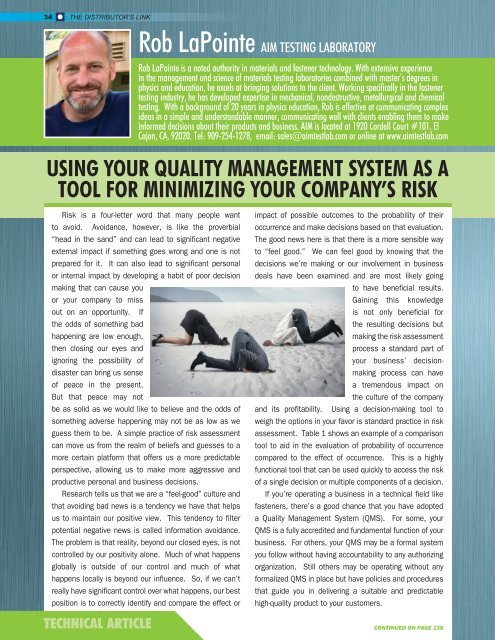SUMMER 2019
Distributor's Link Magazine Summer 2019 / Vol 42 No3
Distributor's Link Magazine Summer 2019 / Vol 42 No3
Create successful ePaper yourself
Turn your PDF publications into a flip-book with our unique Google optimized e-Paper software.
34<br />
THE DISTRIBUTOR’S LINK<br />
Rob LaPointe AIM TESTING LABORATORY<br />
Rob LaPointe is a noted authority in materials and fastener technology. With extensive experience<br />
in the management and science of materials testing laboratories combined with master’s degrees in<br />
physics and education, he excels at bringing solutions to the client. Working specifically in the fastener<br />
testing industry, he has developed expertise in mechanical, nondestructive, metallurgical and chemical<br />
testing. With a background of 20 years in physics education, Rob is effective at communicating complex<br />
ideas in a simple and understandable manner, communicating well with clients enabling them to make<br />
informed decisions about their products and business. AIM is located at 1920 Cordell Court #101, El<br />
Cajon, CA, 92020. Tel: 909-254-1278, email: sales@aimtestlab.com or online at www.aimtestlab.com<br />
USING YOUR QUALITY MANAGEMENT SYSTEM AS A<br />
TOOL FOR MINIMIZING YOUR COMPANY’S RISK<br />
Risk is a four-letter word that many people want<br />
to avoid. Avoidance, however, is like the proverbial<br />
“head in the sand” and can lead to significant negative<br />
external impact if something goes wrong and one is not<br />
prepared for it. It can also lead to significant personal<br />
or internal impact by developing a habit of poor decision<br />
making that can cause you<br />
or your company to miss<br />
out on an opportunity. If<br />
the odds of something bad<br />
happening are low enough,<br />
then closing our eyes and<br />
ignoring the possibility of<br />
disaster can bring us sense<br />
of peace in the present.<br />
But that peace may not<br />
be as solid as we would like to believe and the odds of<br />
something adverse happening may not be as low as we<br />
guess them to be. A simple practice of risk assessment<br />
can move us from the realm of beliefs and guesses to a<br />
more certain platform that offers us a more predictable<br />
perspective, allowing us to make more aggressive and<br />
productive personal and business decisions.<br />
Research tells us that we are a “feel-good” culture and<br />
that avoiding bad news is a tendency we have that helps<br />
us to maintain our positive view. This tendency to filter<br />
potential negative news is called information avoidance.<br />
The problem is that reality, beyond our closed eyes, is not<br />
controlled by our positivity alone. Much of what happens<br />
globally is outside of our control and much of what<br />
happens locally is beyond our influence. So, if we can’t<br />
really have significant control over what happens, our best<br />
position is to correctly identify and compare the effect or<br />
TECHNICAL ARTICLE<br />
impact of possible outcomes to the probability of their<br />
occurrence and make decisions based on that evaluation.<br />
The good news here is that there is a more sensible way<br />
to “feel good.” We can feel good by knowing that the<br />
decisions we’re making or our involvement in business<br />
deals have been examined and are most likely going<br />
to have beneficial results.<br />
Gaining this knowledge<br />
is not only beneficial for<br />
the resulting decisions but<br />
making the risk assessment<br />
process a standard part of<br />
your business’ decisionmaking<br />
process can have<br />
a tremendous impact on<br />
the culture of the company<br />
and its profitability. Using a decision-making tool to<br />
weigh the options in your favor is standard practice in risk<br />
assessment. Table 1 shows an example of a comparison<br />
tool to aid in the evaluation of probability of occurrence<br />
compared to the effect of occurrence. This is a highly<br />
functional tool that can be used quickly to access the risk<br />
of a single decision or multiple components of a decision.<br />
If you’re operating a business in a technical field like<br />
fasteners, there’s a good chance that you have adopted<br />
a Quality Management System (QMS). For some, your<br />
QMS is a fully accredited and fundamental function of your<br />
business. For others, your QMS may be a formal system<br />
you follow without having accountability to any authorizing<br />
organization. Still others may be operating without any<br />
formalized QMS in place but have policies and procedures<br />
that guide you in delivering a suitable and predictable<br />
high-quality product to your customers.<br />
CONTINUED ON PAGE 136

















